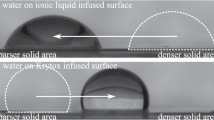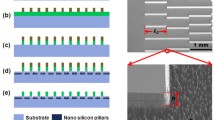Abstract
The behavior of droplets trapped in geometric structures is essential to droplet manipulation applications such as for droplet transport. Here we show that directional droplet movement can be realized by a V-shaped groove with the movement direction controlled by adjusting the surface wettability of the groove inner wall and the cross sectional angle of the groove. Experiments and analyses show that a droplet in a superhydrophobic groove translates from the immersed state to the suspended state as the cross sectional angle of the groove decreases and the suspended droplet departs from the groove bottom as the droplet volume increases. We also demonstrate that this simple grooved structure can be used to separate a water-oil mixture and generate droplets with the desired sizes. The structural effect actuated droplet movements provide a controllable droplet transport method which can be used in a wide range of droplet manipulation applications.
Similar content being viewed by others
Introduction
The dynamic behavior of droplets has drawn much attention in recent years due to its fundamental effect in many practical applications. Generally, droplets can be manipulated by a surface free energy gradient1,2,3,4,5,6,7,8, temperature gradient9,10, or forces in confined geometric structures11,Supplementary Figure 2). The grooved structure was folded from a copper sheet and connected to step** drives on each side. In this way, the cross section angle β of the groove could be adjusted in real time to the desired values. The microsyringe system was used to generate droplets with the desired volumes for the wetting mode measurements and to adjust the droplet volume in real time for the droplet growth observations. The surface wettabilities, including the apparent contact angle θ, advancing contact angle θa and receding contact angle θr, were measured by an OCAH200 contact angle system (Dataphysics, Germany, ±0.1°) with the results listed in Table 1. The experiments are conducted in an ambient environment with room temperatures of 18~24 °C and relative humidities of 35~45% RH.
Experimental procedure
The droplet growth was simulated with a 2 μL water droplet placed in the groove with a microsyringe needle then inserted into the droplet to supply water at a constant flow rate of 0.06 μL/s. The effect of the inserted needle on the droplet movement can be neglected since its contact angle is ~90° and it has a relatively small diameter. In the evaporation experiments, a 4 μL water droplet was placed in the groove and then the droplet was allowed to evaporate by exposure to the ambient environment.
Imaging
The experimental images were captured by the CCD camera of the OCAH200 system with a resolution of 752 × 484 pixels and frame rate of 60 fps. The image overlap** in Fig. 5 was conducted in Photoshop with the “Difference” blend mode.
Materials
The V-shaped grooved structures were folded from a copper sheet. The groove surfaces (inner walls) were treated with W0.5 abrasive paste polishing, 180# sandpaper grinding and chemical etching40 followed by the addition of a self-assembled monolayer (SAM) of n-Octadecyl mercaptan41. The fabricated groove structures are referred to as Smooth, Smooth SAM, Rough SAM and Etched SAM grooves depending on the fabrication method. The PVD surface was fabricated using physical vapor deposition42 of 1H, 1H, 2H, 2H-Perfluorooctyltrichlorosilane on the chemically etched copper surface40. Deionized water, glycerol, kerosene and ethylene glycol were used to generate the droplets and for observations of the resting state.
Additional Information
How to cite this article: Xu, W. et al. Directional Movement of Droplets in Grooves: Suspended or Immersed? Sci. Rep. 6, 18836; doi: 10.1038/srep18836 (2016).
References
Scriven, L. E. & Stemling, C. V. The Marangoni effects. Nature 187, 186–188 (1960).
Chaudhury, M. K. & Whitesides, G. M. How to make water run uphill. Science 256, 1539–1541 (1992).
Edwards, D., Brenner, H. & Wasan, D. Interfacial Transport Processes and Rheology (Butterworth-Heinemann, Boston, 1991).
Daniel, S., Chaudhury, M. K. & Chen, J. C. Fast drop movements resulting from the phase change on a gradient surface. Science 291, 633–636 (2001).
De Gennes, P. G., Brochard-Wyart, F. & Quéré, D. Capillarity and Wetting Phenomena (Springer, New York, 2003).
Subramanian, R. S., Moumen, N. & McLaughlin, J. B. Motion of a drop on a solid surface due to a wettability gradient. Langmuir 21, 11844–11849 (2005).
Zhu, X., Wang, H., Liao, Q., Ding, Y. D. & Gu, Y. B. Experiments and analysis on self-motion behaviors of liquid droplets on gradient surfaces. Exp. Therm. Fluid Sci. 33, 947–954 (2009).
Hancock, M. J., He, J., Mano, J. F. & Khademhosseini, A. Surface-tension-driven gradient generation in a fluid stripe for bench-top and microwell applications. Small 7, 892–901 (2011).
Cazabat, A. M., Heslot, F., Troian, S. M. & Carles, P. Fingering instability of thin spreading films driven by temperature gradients. Nature 346, 824–826 (1990).
Chen, Z. H. & Utaka, Y. Characteristics of condensate drop movement with application of bulk surface temperature gradient in Marangoni dropwise condensation. Int. J. Heat Mass Tran. 54, 5049–5059 (2011).
Shanahan, M. E. R. On the behavior of dew drops. Langmuir 27, 14919–14922 (2011).
Luo, C., Heng, X. & **ang, M. M. Behavior of a liquid drop between two nonparallel plates. Langmuir 30, 8373–8380 (2014).
Lv, C. et al. Substrate curvature gradient drives rapid droplet motion. Phys. Rev. Lett. 113, 026101 (2014).
Rubega, M. A. & Obst, B. S. Surface-tension feeding in phalaropes: Discovery of a novel feeding mechanism. Auk 110, 169–178 (1993).
Rubega, M. A. Surface tension prey transport in shorebirds: how widespread is it ? IBIS 139, 488–493 (1997).
Estrella, S. M., Masero, J. A. & Perez-Hurtado, A. Small-prey profitability: Field analysis of shorebirds’ use of surface tension of water to transport prey. Auk 124, 1244–1253 (2007).
Prakash, M., Quéré, D. & Bush, J. W. M. Surface tension transport of prey by feeding shorebirds-the capillary ratchet. Science 320, 931–934 (2008).
Andrews, H. G., Eccles, E. A., Schofield, W. C. E. & Badyal, J. P. S. Three-dimensional hierarchical structures for fog harvesting. Langmuir 27, 3798–3802 (2011).
Zhao, H. & Daniel, B. From droplet growth to film growth on a heterogeneous surface: condensation associated with a wettability gradient. Langmuir 11, 627–634 (1995).
Malvadkar, N. A., Hancock, M. J., Sekeroglu, K., Dressick, W. J. & Demirel, M. C. An engineered anisotropic nanofilm with unidirectional wetting properties. Nat. Mater. 9, 1023–1028 (2010).
Weislogel, M. M., Baker, J. A. & Jenson, R. M. Quasi-steady capillarity-driven flows in slender containers with interior edges. J. Fluid Mech. 685, 271–305 (2011).
**ng, S. Y., Harake, R. S. & Pan, T. R. Droplet-driven transports on superhydrophobic-patterned surface microfluidics. Lab Chip 11, 3642–3648 (2011).
Shabani, R. & Cho, H. J. Active surface tension driven micropump using droplet/meniscus pressure gradient. Sensor Actuator B-Chem. 180, 114–121 (2013).
Piroird, K. & Lorenceau, É. Capillary flow of oil in a single foam microchannel. Phys. Rev. Lett. 111, 234503 (2013).
Li, J., Tian, X. L., Perros, A. P., Franssila, S. & Jokinen, V. Self-propelling and positioning of droplets using continuous topography gradient surface. Adv. Mater. Interfaces 1, 1400001 (2014).
Luo, C. & Heng, X. Separation of oil from a water/oil mixed drop using two nonparallel plates. Langmuir 30, 10002–10010 (2014).
Heng, X. & Luo, C. Bioinspired plate-based fog collectors. ACS Appl. Mater. Interfaces 6, 16257–16266 (2014).
Wenzel, R. N. Resistance of solid surfaces to wetting by water. Ind. Eng. Chem. 28, 988–994 (1936).
Cassie, A. B. D. & Baxter, S. Wettability of porous surfaces. Trans. Faraday Soc. 40, 546–551 (1944).
Denny, M. W. The intrigue of the interface. Science 320, 886 (2008).
Bico, J., Tordeux, C. & Quéré, D. Rough wetting. Europhys Lett. 55, 214–220 (2001).
Lafuma, A. & Quéré, D. Superhydrophobic states. Nat. Mater. 2, 457–460 (2003).
Marmur, A. Solid-surface characterization by wetting. Annu. Rev. Mater. Res. 39, 473 (2009).
He, B., Patankar, N. A. & Lee, J. Multiple equilibrium droplet shapes and design criterion for rough hydrophobic surfaces. Langmuir 19, 4999–5003 (2003).
Extrand, C. W. Criteria for ultralyophobic surfaces. Langmuir 20, 5013–5018 (2004).
Patankar, N. A. Transition between superhydrophobic states on rough surfaces. Langmuir 20, 7097–7102 (2004).
Rykaczewski, K. et al. How nanorough is rough enough to make a surface superhydrophobic during water condensation ? Soft Matter 8, 8786–8794 (2012).
Tuteja, A. et al. Designing Superoleophobic Surfaces. Science 318, 1618–1622 (2007).
Concus, P. & Finn, R. Discontinuous behavior of liquids between parallel and tilted plates. Phys. Fluids 10, 39–43 (1998).
Enright, R., Dou, N. M. N., Nam, Y. & Wang, E. N. Condensation on superhydrophobic copper oxide nanostructures. J. Heat Trans.-T. ASME 135, 091304 (2013).
Ma, X. H. et al. Wetting mode evolution of steam dropwise condensation on superhydrophobic surface in the presence of noncondensable gas. J. Heat Trans.-T. ASME 134, 021501 (2012).
Miljkovic, N. et al. Jum**-droplet-enhanced condensation on scalable superhydrophobic nanostructured surfaces. Nano Lett. 13, 179−187 (2013).
Acknowledgements
Financial support from the National Natural Science Foundation of China under Grants No. 51236002 and No. 51476018 is gratefully acknowledged. We acknowledge the contribution of Qiancheng Liu, who helped us set up the experimental apparatus and perform the experiments. We also acknowledge the contribution of Prof. Christopher in Tsinghua University, who helped us polish the manuscript.
Author information
Authors and Affiliations
Contributions
X.H.M., Z.L. and W.X. conceived and designed the study. W.X., B.L.P., R.F.W. and Y.S.C. conducted the experiments and model analysis. Z.L. and W.X. wrote the paper. X.H.M. and Z.L. reviewed and edited the manuscript. All authors read and approved the manuscript.
Ethics declarations
Competing interests
The authors declare no competing financial interests.
Rights and permissions
This work is licensed under a Creative Commons Attribution 4.0 International License. The images or other third party material in this article are included in the article’s Creative Commons license, unless indicated otherwise in the credit line; if the material is not included under the Creative Commons license, users will need to obtain permission from the license holder to reproduce the material. To view a copy of this license, visit http://creativecommons.org/licenses/by/4.0/
About this article
Cite this article
Xu, W., Lan, Z., Peng, B. et al. Directional Movement of Droplets in Grooves: Suspended or Immersed?. Sci Rep 6, 18836 (2016). https://doi.org/10.1038/srep18836
Received:
Accepted:
Published:
DOI: https://doi.org/10.1038/srep18836
- Springer Nature Limited
This article is cited by
-
The ejection of large non-oscillating droplets from a hydrophobic wedge in microgravity
npj Microgravity (2021)
-
Bioinspired Unidirectional Liquid Transport Micro-nano Structures: A Review
Journal of Bionic Engineering (2021)
-
Effects of wettability on droplet movement in a V-shaped groove
Scientific Reports (2018)




